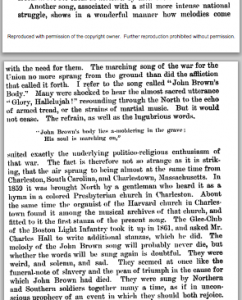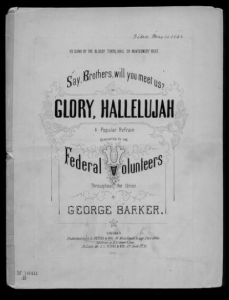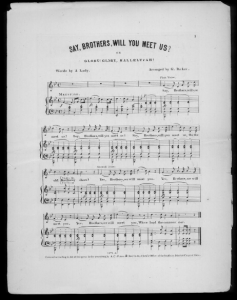In January I applied only slightly more than a whim for a CURI proect researching John Brown. I did not know who he was at all before reading the description, apparently he was a militant abolitionist who perhaps most notably tried to incite a slave revolt in Harper’s Ferry Virginia in 1859. Previously, he had been involved in Bleeding Kansas, leading the Pottawatomie Massacre. He was disastrously unsuccessful at Harper’s Ferry, but became a martyr for the abolitionist cause, and many scholars argue that Brown’s actions and subsequent execution sparked the Civil War.

When I told people my summer plans, most of them either asked me “who is that?” or, they started singing “John Brown’s Body,” at me.
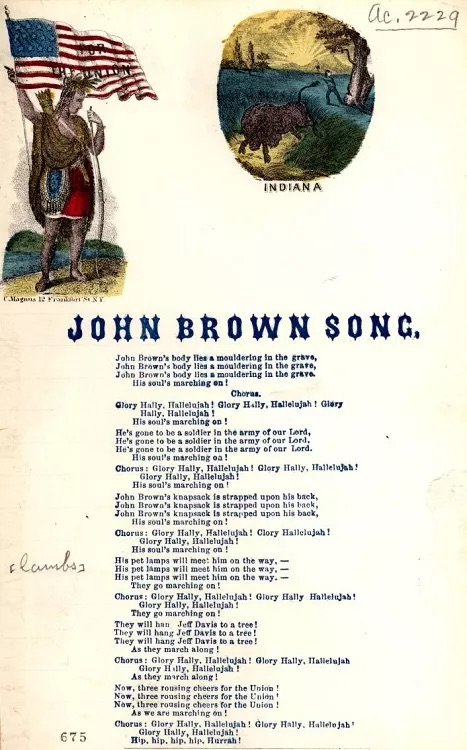
The song, which later became the “Battle Hymn of the Republic,” when Julia Ward Howe used the melody to set a text that tied the Union’s fight in the Civil War to God’s Judgment. The song retains the martial themes of the original marching song, but also, I think, retains the image of John Brown, especially in the lines “as he died to make men holy, let us die to make men free.” It was Ralph Waldo Emerson who most explicitly made the comparison between Brown and Christ, saying in a speech on November 8th that Brown’s execution would “make the gallows as glorious as the cross.” (“Emerson on Courage” The Liberator. November 18th, 1859).
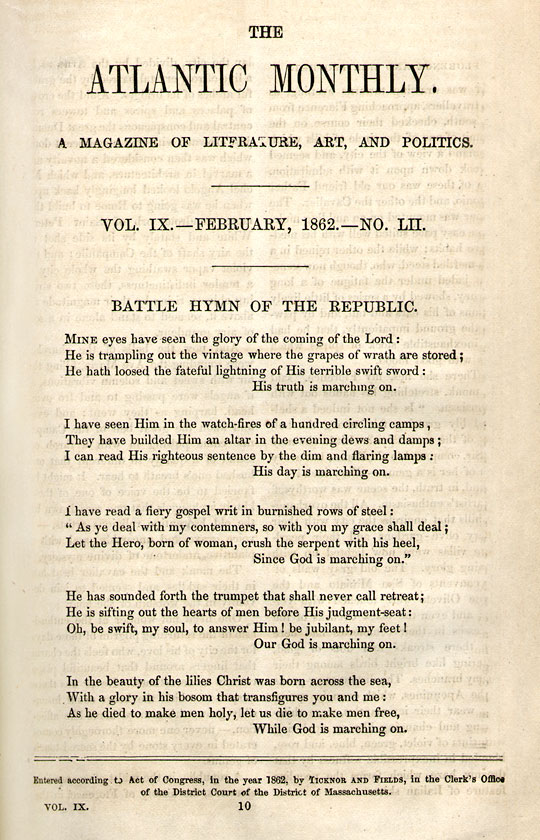
John Brown’s Body, or the Battle Hymn is a catchy piece, (and often people sing verses from both together). It has been the accompaniment for many of my walks around campus since starting my research this summer. I often sing it without really thinking about its edgier theological (at least for our time) and political content. The melody is invigorating, an ascending line, an answering descending line, an ascending line, and a shorter fourth line that brings each statement to a certain conclusion. There are also some lines that are extremely satisfying to sing. “He has loosed the fateful lighting of his terrible swift sword,” is my particular favorite. The refrain of “Glory, Glory Hallelujah” demands to be sung with gusto, and perhaps with righteous anger.
But Lucia, why are you invoking John Brown now, and why with a martial hymn about the wrath of God?
This is a fair question. John Brown is remembered with discomfort. He sought justice with violence. Whether people blanche because of the the violence itself, its extra-judicial nature, or it’s relationship to Brown’s deep Calvinism, the reactions to Brown tell us about our current intuitions about the question “when, and how is violence justified?” The John Brown wrote on a note before his execution saying that he was “quite certain that the crimes of this guilty land; will never be purged away but with Blood,”

However, my research this summer took me beyond these questions, and beyond the apocalyptic vision I have presented so far in Brown’s last note, and the Battle Hymn of the Republic. I feel that there is another song, and another and another apocalyptic vision, which I feel is more representative of the totality of Brown’s life. Brown’s favorite hymn was “Blow ye the trumpet blow.” The text references Leviticus 25, which describes a Jubilee year in which debts would be forgiven, Israelite slaves at least, would be released, among other things. This ritual of atonement is tied in with Christ’s atonement– the real year of Jubilee is Christ’s return for Judgement. But the focus of the hymn is not on God’s wrath, but on the promise of forgiveness and grace.

If we remember John Brown at all, I think most forget this John Brown. His prevailing vision of divine justice was atonement, and redemption. Brown lived the whole of his life according to this hope. The things that aren’t as often discussed with Brown are how in every one of the many places he lived, he was a pillar of the community. He taught Sunday school, as well as just regular school out of his home for his and his neighbors’ children. He made sure his workers could eat and took care of their families. When the Fugitive Slave Law was passed in, he organized and armed a black self defense league, The League of Gileadites. He was active in the underground railroad. These are only a few of his actions. Brown lived out continual atonement and compassion through his whole life. Unlike almost all other white abolitionists it seems he saw black people not as worthy of pity and in need of his righteous intervention, but instead as his companions and compatriots in battle. He better than anyone “remembered those in bonds as bound with them.” (citation) It seems like Brown could see a more just world super-imposed on the unjust one of his times. And this kind of clear-eyed hope unflinching obligation to the just and right whenever it is possible I think is the demand of our times as well.
Brown was, of course, a man with many failings both personal and political (and gramatical, his semicolon usage is truly mystifying). He had a very difficult life. Our society has changed in huge and important ways since his death, but justice still eludes us. Still, spending so much time with John Brown over the past few months has instilled in me an active commitment to hope for atonement and redemption. In a letter he wrote from prison to his family, Brown wrote:
P. S. I cannot remember a night so dark as to have hindered the coming day: nor a storm so furious or dreadful as to prevent the return of warm sunshine and a cloudless sky.
Further Reading:
Fire From the Midst of You: a Religious Life of John Brown, Louis A. DeCaro Jr.
DeCaro also has a wonderful and extensive blog about John Brown, his life, and those who have interpreted it. Seriously, this blog is a treasure!
John Brown Abolitionist: the Man who Killed Slavery, Sparked the Civil War, and Seeded Civil Rights, David S. Reynolds
Tea and Sympathy: Liberals and Other White Hopes, Lerone Bennett Jr. https://archive.org/details/negromoodotheres0000benn/page/74/mode/2up If you read anything from this list, make it this essay.

